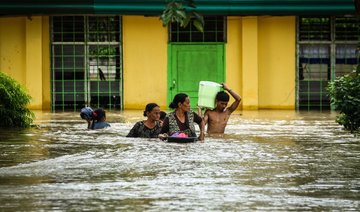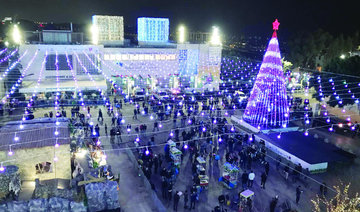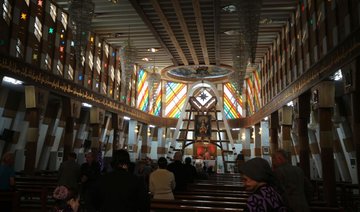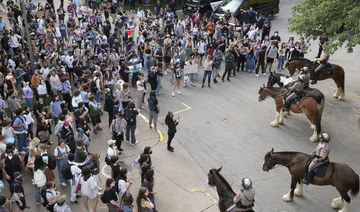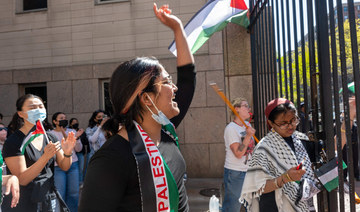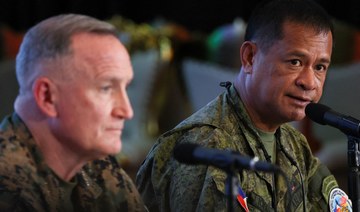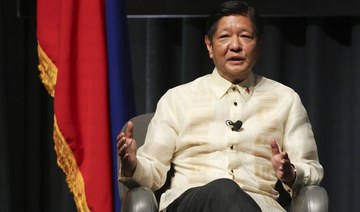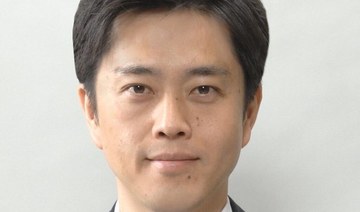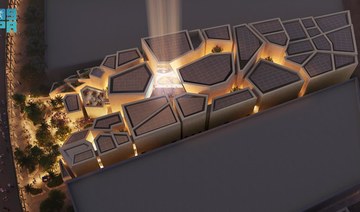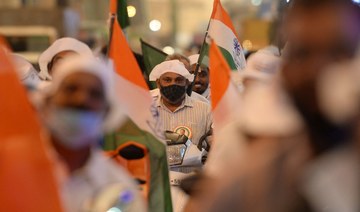VATICAN CITY: Pope Francis in his Christmas eve mass Sunday urged the world’s 1.3 billion Catholics not to ignore the plight of migrants who are “driven from their land” because of leaders willing to shed “innocent blood.”
“So many other footsteps are hidden in the footsteps of Joseph and Mary,” the Argentine pontiff, himself the grandson of Italian migrants, told worshippers in Saint Peter’s Basilica
“We see the tracks of millions of persons who do not choose to go away but, driven from their land, leave behind their dear ones.”
Many engulfed in the ongoing migration crisis were forced to flee from leaders “who, to impose their power and increase their wealth, see no problem in shedding innocent blood,” said the 81-year-old, who will give his traditional “Urbi et Orbi” Christmas address on Monday.
The pontiff’s plea for “hope” came as fresh tensions simmered in the West Bank following Washington’s recognition of Jerusalem as Israel’s capital.
The announcement by US President Donald Trump on December 6 unleashed demonstrators and clashes, including in Bethlehem in the Israeli-occupied West Bank where Christians marked the birth of Jesus at a midnight mass.
On Sunday, Guatemala President Jimmy Morales said his country would move its embassy in Israel from Tel Aviv to Jerusalem, following Trump’s controversial lead.
Celebrating mass in the ancient town, Archbishop Pierbattista Pizzaballa, apostolic administrator of the Latin Patriarch of Jerusalem, used his homily to lambast the wars that “the Herods of today fight every day to become greater, to occupy more space.”
He urged “Christians of the Holy Land, who are worried, and perhaps afraid by the reduction of our numbers, the inadequacy of our means, the insecurity that characterises our daily life,” to have courage in the troubled region.
Criticizing Trump’s announcement, Pizzaballa insisted “Jerusalem is a city of peace, there is not peace if someone is excluded. Jerusalem should include, not exclude,” stressing the principle that Jerusalem is a city for both peoples and the three Abrahamic faiths.
“Jerusalem is our mother,” he said, and if one of her children “is missing the mother cannot be at peace, so we have to pray for the peace of Jerusalem,” the archbishop said in his homily in the presence of Palestinian president Mahmoud Abbas.
Trump’s decision to recognize Jerusalem as the capital of Israel has sparked almost daily protests in the Palestinian territories and put a damper on Christmas festivities.
Palestinian scouts played drums and bagpipes at celebrations in Bethlehem, but many tourists stayed away this year.
Hundreds of people gathered in the cold on Bethlehem’s Manger square to watch the annual scout parade toward the Church of the Nativity, built over the spot where tradition says Mary gave birth to Jesus.
But the square was noticeably quieter following the violence between Palestinian protesters and the Israeli army in the past weeks.
Twelve Palestinians have been killed since Trump’s declaration, including a 19-year-old who died of his wounds on Sunday nine days after he was shot during a Gaza protest.
In the square, Nahil Banura, a Christian woman from Beit Sahur, near Bethlehem, said Trump’s decision had made the run-up to Christmas “miserable.”
“People are only going out to vent,” she said.
The Israeli army officer in charge of the Bethlehem area said that while tensions had been high in the area following the Jerusalem announcement, he did not expect trouble at Christmas.
“We’ve reinforced our troops, and are ready for any scenario,” Lt. Col. Benny Meir told AFP.
Israel seized east Jerusalem in the 1967 Middle East war and later annexed it, in moves never recognized by the international community.
Palestinians view east Jerusalem as the capital of their future state, and interpreted Trump’s statement as rejecting their right to a capital in east Jerusalem, although the Americans deny this.
In a statement earlier, Abbas called on “world Christians to listen to the true voices of the indigenous Christians from the Holy Land... that strongly rejected the US recognition of Jerusalem as Israel’s capital.”
Mitri Raheb, pastor of the Evangelical Lutheran Christmas Church in Bethlehem, told AFP that Christmas this year is a “mix of sadness and joy” because of the US decision on Jerusalem, which he called “the beating heart of Palestine.”
Christmas decorations have meanwhile become more visible in Christian areas of Syria’s capital Damascus this year.
In the central Syrian city of Homs, Christians will celebrate Christmas with great fanfare for the first time in years after the end of battles between regime and rebel forces, with processions, shows for children and even decorations among the ruins.
In Iraq too, this year marks a positive turning point for the Christian community in the northern city of Mosul.
Hymns filled a Mosul church on Sunday as worshippers celebrated Christmas for the first time in four years after the city’s recapture from the Daesh group in July.
Muslims stood alongside Christian worshippers amid the candles and Christmas trees at St. Paul’s Church in Mosul.
Pope pleads for migrants at Christmas mass
Pope pleads for migrants at Christmas mass
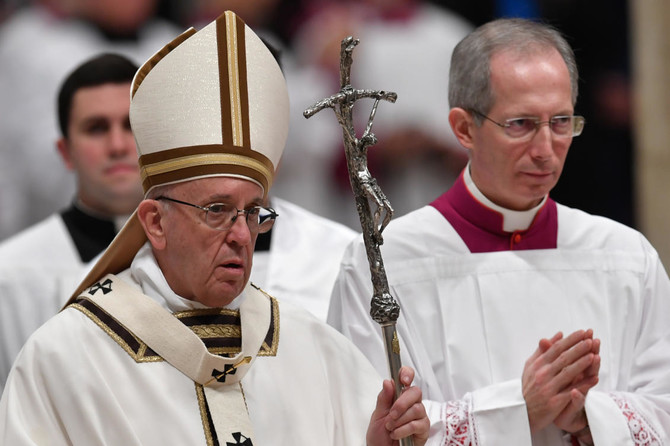
Berlin police clear pro-Palestinian camp from parliament lawn
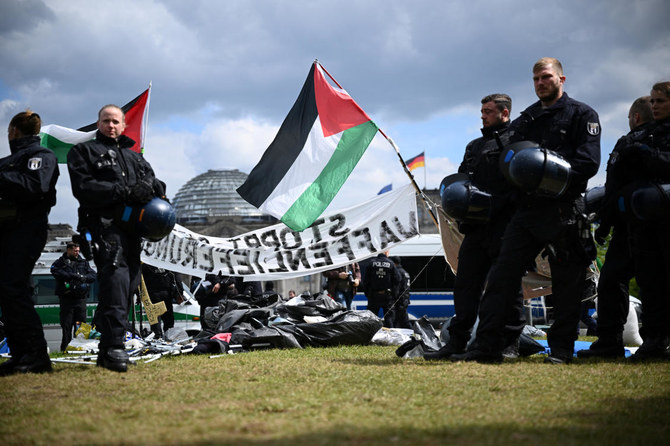
- Police dismantled tents, forcibly removed protesters and blocked the surrounding area to stop others arriving
- "The idea was to draw attention to that and ... to the German complicity and active enabling of the Israeli genocide in Gaza," the camp organizer, Jara Nassar, said
BERLIN: Berlin police on Friday began clearing a pro-Palestinian camp set up in front of the German parliament by activists demanding the government stop arms exports to Israel and end what they say is the criminalization of the Palestinian solidarity movement.
Police dismantled tents, forcibly removed protesters and blocked the surrounding area to stop others arriving.
The action followed clashes between demonstrators and police on US campuses and a blockade at Paris’s Sciences Po university, part of international protests to decry Israel’s military campaign in Gaza and Western support for Israel.
The Berlin camp ‘Besetzung Gegen Besatzung’ — ‘Occupy Against Occupation’ — began on April 8, coinciding with the start of International Court of Justice hearings in Nicaragua’s case against Germany for providing military aid to Israel.
“The idea was to draw attention to that and ... to the German complicity and active enabling of the Israeli genocide in Gaza,” the camp organizer, Jara Nassar, told Reuters.
Israel strongly denies accusations that its offensive in Gaza, which aims to destroy the Palestinian militant group Hamas, constitutes a genocide.
Nassar and a dozen protesters sat on the ground, chanting pro-Palestinian slogans and songs as police with loudspeakers called on them to leave.
“We look at what is happening in the US ... with admiration. There is no reason to believe we should stop now,” said Udi Raz, a PhD student at Berlin’s Free University and a member of the Jewish Voice association.
Raz, who wore a Jewish kippah with the Palestinian flag colors and held his phone in a live social media broadcast of the clearance, said Jewish activists had joined the camp and held a candle-lit Passover dinner there this week.
Police said the prohibition order for the camp, which had been granted authorization at the start of the protest, was due to repeated violations committed by some protesters, including the use of unconstitutional symbols and forbidden slogans.
“Protection of gatherings cannot be guaranteed at this point because public safety and order are significantly at risk,” police spokesperson Anja Dierschkesaid said, adding tents had to be moved daily under local regulations to maintain the lawn.
“For the German government, grass matters more than the lives of more than 40,000 innocent people in Gaza murdered by the Israeli military,” Raz said.
Philippine police kill an Abu Sayyaf militant implicated in 15 beheadings and other atrocities
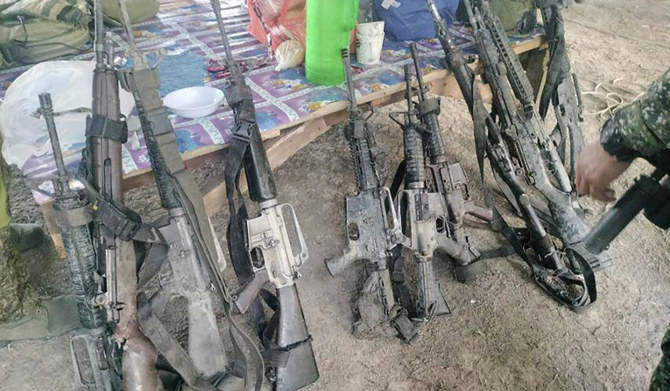
- A confidential police report said that Abdulsaid had been implicated in at least 15 beheadings in Basilan, including of 10 Philippine marines in Al-Barka town in 2007 and two of six kidnapped Vietnamese sailors near Sumisip town in 2016
MANILA: Philippine forces killed an Abu Sayyaf militant, who had been implicated in past beheadings, including of 10 Filipino marines and two kidnapped Vietnamese, in a clash in the south, police officials said Friday.
Philippine police, backed by military intelligence agents, killed Nawapi Abdulsaid in a brief gunbattle Wednesday night in the remote coastal town of Hadji Mohammad Ajul on Basilan island after weeks of surveillance, security officials said.
Abu Sayyaf is a small but violent armed Muslim group, which has been blacklisted by the US and the Philippines as a terrorist organization for ransom kidnappings, beheadings, bombings and other bloody attacks. It has been considerably weakened by battle setbacks, surrenders and infighting, but remains a security threat particularly in the southern Philippines, home to minority Muslims in the predominantly Roman Catholic nation.
Abdulsaid, who used the nom de guerre Khatan, was one of several Abu Sayyaf militants who aligned themselves with the Daesh group.
A confidential police report said that Abdulsaid had been implicated in at least 15 beheadings in Basilan, including of 10 Philippine marines in Al-Barka town in 2007 and two of six kidnapped Vietnamese sailors near Sumisip town in 2016. The Vietnamese were seized from a passing cargo ship.
He was also involved in attacks against government forces in 2022 and a bombing in November that killed two pro-government militiamen and wounded two others in Basilan, the report said.
Abdulsaid was placed under surveillance in February, but police forces couldn’t immediately move to make a arrest because of the “hostile nature” of the area where he was eventually gunned down, according to the report.
On Monday, Philippine troops killed the leader of another Muslim rebel group and 11 of his men blamed for past bombings and extortion in a separate clash in a marshy hinterland in Datu Saudi Ampatuan town in southern Maguindanao del Sur province, the military said.
Seven soldiers were wounded in the clash with the members of the Bangsamoro Islamic Freedom Fighters.
The Abu Sayyaf and the Bangsamoro Islamic Freedom Fighters are among a few small armed groups still struggling to wage a separatist uprising in the southern Philippines.
The largest armed separatist group, the Moro Islamic Liberation Front, signed a 2014 peace pact with the government that eased decades of sporadic fighting.
Moro Islamic Liberation Front rebel commanders became parliamentarians and administrators of a five-province Muslim autonomous region in a transition arrangement after signing the peace deal. They are preparing for a regular election scheduled for next year.
Saudi Pavilion at Expo 2025 Osaka: A journey through Saudi Arabia’s transformation, Vision for Future
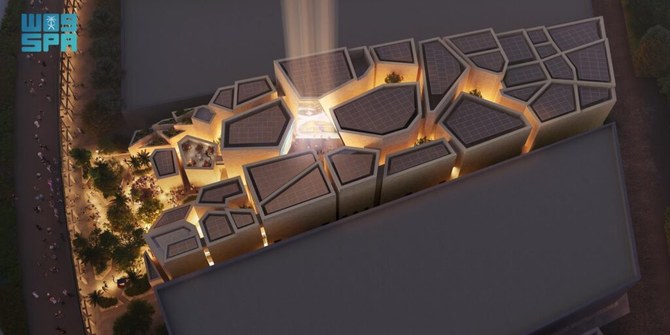
- Saudi chefs will present a mix of flavours inspired by different regions of the Kingdom
- More than 200 selections of souvenirs will be displayed in the gift shop, each a testament to authentic Saudi craftsmanship
OSAKA: The Saudi pavilion participating in Expo 2025 Osaka in Japan has announced an unprecedented cultural and artistic program encompassing more than 700 events to introduce visitors to Saudi Arabia’s rich heritage, mega projects and various economic opportunities.
The Saudi pavilion at the expo will present Saudi Arabia’s past, transformational journey and vision for a sustainable and prosperous future. It will include a wide range of performances, such as traditional arts, classical music and fashion shows.
Saudi chefs will present a mix of flavours inspired by different regions of the Kingdom, and Saudi musicians and artists will perform daily to highlight the Kingdom’s rich cultural heritage.
A dedicated area for prominent figures will host various sessions and display a series of presentations to inform companies and investors of all the economic opportunities available in the Kingdom.
More than 200 selections of souvenirs will be displayed in the gift shop, each a testament to authentic Saudi craftsmanship.
Visitors from around the world will learn about AlUla City, located in north-west Saudi Arabia, which is home to dramatic desert landscapes, spectacular rock formations and some of the Middle East’s most significant ancient sites.
Major Saudi projects will be highlighted, including NEOM, the land of the future; THE LINE, the 170-kilometer-long city that will be the future of urban living; Oxagon, which is redefining the traditional industrial model; and Trojena, the mountain resort of NEOM.
The pavilion will also showcase aspects of ‘Green Riyadh,’ a revolutionary project that aims to transform Saudi Arabia’s capital into a green oasis by planting 7.5 million trees by 2030. This project aims to place Riyadh as one of the world’s top 100 most livable cities.
It will also highlight the Reefscape Restoration Initiative, launched by the King Abdullah University of Science and Technology (KAUST). This initiative seeks to conserve, enhance, and restore 100 hectares of coral reefscape in the Red Sea and design and build the world’s largest Coral Nursery at Jeddah beach, with an expected coral production of 400k per year.
General Commissioner of the Saudi Pavilion Othman Al-Mazyad said: “We look forward to enabling visitors of the Saudi pavilion to learn about the Kingdom, its traditions, journey of transformation and vision for a sustainable future.”
Relations between Saudi Arabia and Japan have been continuously growing, thanks to the Saudi-Japanese Vision 2030. The Saudi Pavilion at Expo 2025 Osaka will allow companies and investors from Japan and worldwide to learn about the Kingdom’s various opportunities, aiming to forge new partnerships and expand existing agreements.
India’s mammoth election heats up in trend-defining second phase
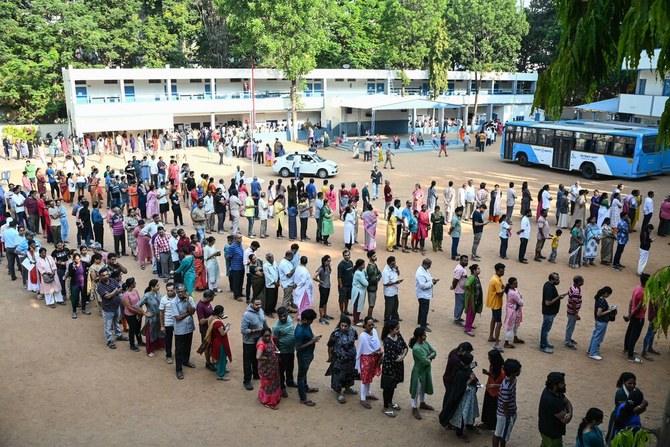
- Second phase is seen by analysts as defining dynamics of rest of the polls
- Turnout in first phase was lower than expected — 66 percent, compared with 70 percent in 2019
NEW DELHI: India’s mammoth general election rolled on Friday into its second phase, which is widely believed to likely set the trend for the rest of the polls.
More than 968 million voters were registered to cast the ballot vote in the world’s most populous country, where incumbent Prime Minister Narendra Modi and his Hindu nationalist Bharatiya Janata Party are eyeing a rare third straight five-year term in power.
The first phase of the vote was on April 19 as polling takes place over six weeks, with results expected on June 4. The other voting dates will be May 7, May 13, May 20, May 25 and June 1.
India has a total of 28 states and eight federally governed territories. Some regions complete the process on a single day, and others spread it out over several phases.
Voting last week took place in 21 states and union territories, with nearly 169 million people eligible to cast their ballots. In the second phase, more than 160 million people were expected to vote across 13 states and federal territories.
As many as 1,202 candidates contested the polls on Friday, vying for 88 of the 543 seats in the lower house of Parliament. In the previous phase, 102 seats were up for grabs.
More than half of the 88 seats were in the southern states of Kerala and Karnataka and the northwestern state of Rajasthan.
The party or coalition that wins at least 272 seats will form the government.
Modi, who ahead of the election was targeting 400 seats for his BJP-led National Democratic Alliance, is challenged by an alliance of two dozen opposition parties — the Indian National Developmental Inclusive Alliance, or INDIA, led by the Congress party, which has ruled the country for close to 45 years since independence in 1947.
‘MINI-GENERAL ELECTION’
The second phase of India’s polls is seen by analysts as defining the dynamics of the remaining five phases. One of the factors was the voter turnout, which in this election might be lower.
In the first phase, 66 percent of those eligible to vote cast their ballot — compared with 70 percent in 2019.
“From the first phase of the election, the message went that there is a silent undercurrent against the BJP and the dip in the voting percentage sent the signal that the BJP would slip in its strongholds in northern India particularly Uttar Pradesh,” Umakant Lakhera, political commentator in Delhi, told Arab News.
“If the trend of voters’ perceived apathy toward the election in general — and the BJP in particular — continues, then it’s an opportunity for the opposition Congress party to consolidate and mobilize its resources to widen its reach and capitalize on anti BJP sentiment.”
The key leader of the opposition coalition and Congress member is Rahul Gandhi, the son of Rajiv Gandhi, a grandson of Indira Gandhi, and a great-grandson of Jawaharlal Nehru, all of whom served as prime ministers of India.
Gandhi is seeking re-election from Wayanad in Kerala — the only major state that has never elected a BJP member of parliament, and where it was not a main competitor. This year, Modi’s party has been trying to make inroads into the state’s political scene.
The main contenders, besides Gandhi, are Annie Raja of the Communist Party of India and BJP’s K. Surendran.
“Kerala always has witnessed bipolar politics, but the BJP has been trying this time to make it a triangular contest, and this election will test whether a third force can find space in Kerala or not,” Prof. G. Gopa Kumar, political scientist and adviser to the Kerala-based Center for Public Policy Research, told Arab News.
“The second phase will test whether the stigma of the BJP of being an outsider in Kerala will continue or not, whether the stigma of not winning a seat in Kerala will continue or not.”
Far from Kerala, in the north, where several states were also going to the polls, another test was taking place at the same time — for the Congress party. Congress plunged to a historic low when it was swept out of power by the BJP in the 2014 general vote, and won its second-lowest number of 52 seats in 2019.
“The second phase is a mini-general election. What is at stake is whether the Congress is going to challenge the dominance of the BJP in the north Indian states like Uttar Pradesh, Rajasthan, Madhya Pradesh or not,” Kumar said.
“The contest is getting serious from now on. For the Congress, it is a survival question as they have to prove that they can defeat the BJP and survive as a big force.”
Although surveys suggest Modi will easily win a comfortable majority in parliament, his 400-seat target, often repeated ahead of the polls, has not been cited since last week’s first phase.
Asad Rizvi, an analyst based in Lucknow, the capital of India’s most populous state and BJP stronghold, Uttar Pradesh, said that the performance was apparently not as good as expected, despite the repetition of the party’s tactics of polarization along religious lines.
“A perception has come to dominate after the first phase of elections that the BJP has not performed well in its strongholds in Uttar Pradesh, therefore, the BJP will have a tough time mobilizing its core voters to retain the seats,” he told Arab News.
“The second phase is also crucial that will test whether the BJP’s communal agenda is working or not.”
Ukraine’s Zelensky calls for air defense systems as allies meet
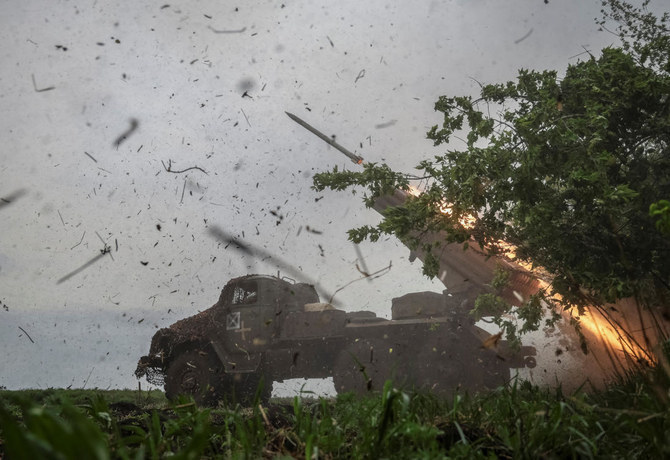
- “We need the ability to shoot down the air combat aircraft so that they do not approach our positions and borders,” Zelensky said
- US Defense Secretary Lloyd Austin said the meeting would focus on Ukraine’s air defense capabilities
WASHINGTON: Ukrainian President Volodymyr Zelensky on Friday called for additional air defense systems to be sent to Kyiv to help protect against Russian strikes, adding that a pause in US funding had helped Moscow seize the initiative.
“This year, Russian jets (have) already used more than 9,000 guided aerial bombs against Ukraine and we need the ability to shoot down the air combat aircraft so that they do not approach our positions and borders,” Zelensky said at the start of a virtual meeting led by the United States on helping arm Ukraine.
US Defense Secretary Lloyd Austin said the meeting would focus on Ukraine’s air defense capabilities.
The meeting comes days after Congress emerged from a half-year of deadlock to approve a $61 billion aid package for Ukraine. President Joe Biden’s administration quickly announced $1 billion in artillery, air defenses and other hardware would soon be heading to Ukrainian front lines.
“While we were waiting for a decision on the American support, the Russian army managed to seize the initiative on the battlefield,” Zelensky said.
“We can still now, not only stabilize the front, but also move forward achieving our Ukrainian goals in the war,” he added.
The United States hopes its new deliveries of weaponry will help Ukraine rebuild defenses and refit its forces as it recovers from a gap in US assistance, but it does not expect Kyiv to launch large-scale offensive operations against Russian forces in the near term.
The influx of weapons could improve Kyiv’s chances of averting a major Russian breakthrough in the east, just over two years since the start of Moscow’s full-scale invasion, military analysts say.
But it remains unclear how much pressure Kyiv can apply on Russia after months of rationing artillery as its stocks ran low. Kyiv also faces manpower shortages on the battlefield and questions linger over the strength of its fortifications along a sprawling, 1,000-km (621-mile) front line.


